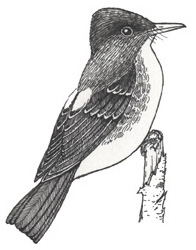

They breed in Alaska, across Canada to northern New England, and New York and in the western U.S., south into the mountains in California, and the southwest. They spend the winters in Central and South America.
They are found in moist coniferous forests and bogs.
They are olive-brown on top with dark shoulders and sides, and white down the center of their breast. They have white tufts under wings and a large head and bill.
They sit (perch) on dead trees to watch for insects they can fly out and catch.
They eat insects.
They make an open cup nest of twigs and line it with grass and moss. They place the nest way out at the end of a branch of a conifer, safe from predators. The female lays 3 tan eggs with brown spots.
Kingdom: Animalia
Phylum: Chordata
Subphylum: Vetebrata
Class: Aves
Order: Piciformes
Family: Tyrannidae
Genus: Contopus
Species: C. cooperi
When you research information you must cite the reference. Citing for websites is different from citing from books, magazines and periodicals. The style of citing shown here is from the MLA Style Citations (Modern Language Association).
When citing a WEBSITE the general format is as follows.
Author Last Name, First Name(s). "Title: Subtitle of Part of Web Page, if appropriate." Title: Subtitle: Section of Page if appropriate. Sponsoring/Publishing Agency, If Given. Additional significant descriptive information. Date of Electronic Publication or other Date, such as Last Updated. Day Month Year of access < URL >.
Amsel, Sheri. "Flycatcher (Olive-sided)" Exploring Nature Educational Resource ©2005-2024. December 13, 2024
< http://www.exploringnature.org/db/view/Flycatcher-Olive-sided >

